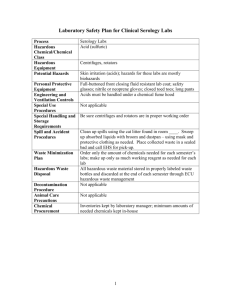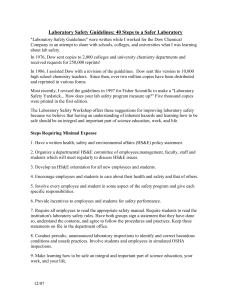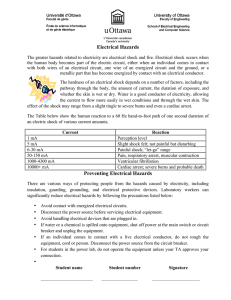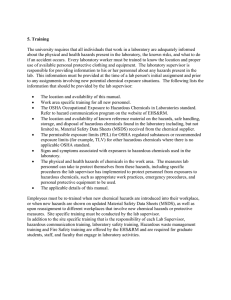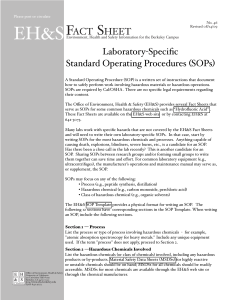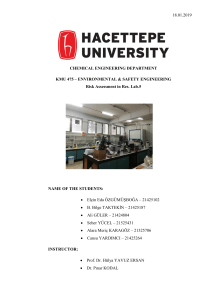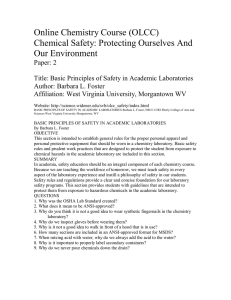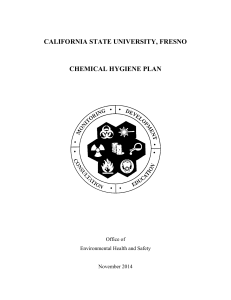3. General Laboratory Safety 3.1 Standard Operating Procedures
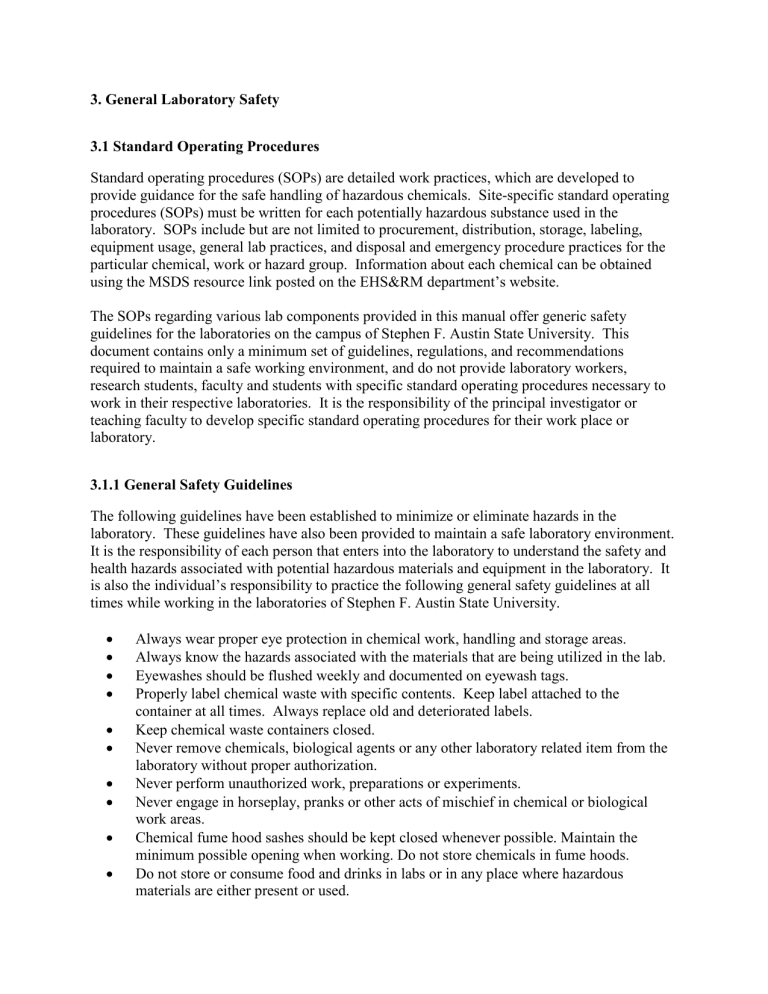
3. General Laboratory Safety
3.1 Standard Operating Procedures
Standard operating procedures (SOPs) are detailed work practices, which are developed to provide guidance for the safe handling of hazardous chemicals. Site-specific standard operating procedures (SOPs) must be written for each potentially hazardous substance used in the laboratory. SOPs include but are not limited to procurement, distribution, storage, labeling, equipment usage, general lab practices, and disposal and emergency procedure practices for the particular chemical, work or hazard group. Information about each chemical can be obtained using the MSDS resource link posted on the EHS&RM department’s website.
The SOPs regarding various lab components provided in this manual offer generic safety guidelines for the laboratories on the campus of Stephen F. Austin State University. This document contains only a minimum set of guidelines, regulations, and recommendations required to maintain a safe working environment, and do not provide laboratory workers, research students, faculty and students with specific standard operating procedures necessary to work in their respective laboratories. It is the responsibility of the principal investigator or teaching faculty to develop specific standard operating procedures for their work place or laboratory.
3.1.1 General Safety Guidelines
The following guidelines have been established to minimize or eliminate hazards in the laboratory. These guidelines have also been provided to maintain a safe laboratory environment.
It is the responsibility of each person that enters into the laboratory to understand the safety and health hazards associated with potential hazardous materials and equipment in the laboratory. It is also the individual’s responsibility to practice the following general safety guidelines at all times while working in the laboratories of Stephen F. Austin State University.
•
Always wear proper eye protection in chemical work, handling and storage areas.
•
Always know the hazards associated with the materials that are being utilized in the lab.
•
Eyewashes should be flushed weekly and documented on eyewash tags.
•
Properly label chemical waste with specific contents. Keep label attached to the container at all times. Always replace old and deteriorated labels.
•
Keep chemical waste containers closed.
•
Never remove chemicals, biological agents or any other laboratory related item from the laboratory without proper authorization.
•
Never perform unauthorized work, preparations or experiments.
•
Never engage in horseplay, pranks or other acts of mischief in chemical or biological work areas.
•
Chemical fume hood sashes should be kept closed whenever possible. Maintain the minimum possible opening when working. Do not store chemicals in fume hoods.
•
Do not store or consume food and drinks in labs or in any place where hazardous materials are either present or used.
•
Food or drinks and chemicals should not be stored in the same refrigerator.
•
Do not wear shorts or open-toed shoes in labs. Wear appropriate personal protective equipment when working in labs where hazardous materials are present.
•
Always wash hands and arms with soap and water before leaving the work area. This applies even if you are wearing gloves.
•
Remove clutter and practice good housekeeping.
•
Confine long hair and loose clothing.
•
Do not use cell phones, Bluetooth and MP3 players while working in the lab.
•
Never leave an open flame unattended. Know the location of the nearest fire extinguisher.
Never leave an experiment unattended while it is being heated or is rapidly reacting.
•
Do not keep or work with flammable substances near a flame.
•
Secure gas cylinders properly and keep safety caps on cylinders when not in use.
•
Have appropriate spill supplies available and follow response procedures.
•
Eliminate extension cords and power strips in series. No exposed wiring.
•
Keep exits and aisles clear of obstructions.
•
Emergency equipment should be clear of obstructions. Be familiar with the location of emergency equipment – fire alarm, fire extinguisher, emergency eye wash and safety shower. Know the appropriate emergency response procedures.
•
Glass chemical bottles should not be stored on the floor.
•
Do not store any lab equipment or chemicals in corridors.
•
Keep equipment back from the edge of the lab bench to prevent spillage.
•
Report any accident immediately, however minor or irrelevant you might think it might be.

